Abstract
Six monkeys self-administered orally delivered phencyclidine ("angel dust") and saccharin under concurrent fixed-ratio 16 schedules during daily three-hour sessions. Liquid deliveries were contingent upon lip-contact responses on solenoid-operated drinking spouts. Three saccharin concentrations (0.003%, 0.03% and 0.3%, wt/vol) were tested in a nonsystematic order. For each saccharin concentration, the following series of phencyclidine concentrations (mg/ml) was presented: 0.25, 0.5, 1, 0.25 (retest), 0.125, 0.0625, 0.0312, 0.25 (retest) and 0 (water with stimuli signaling phencyclidine). As the saccharin concentration increased, the number of drug deliveries decreased, and the peaks of the concentration-response functions were shifted to the right. The lowest saccharin concentration (0.003%, wt/vol) maintained responding in excess of phencyclidine levels in only one monkey. The two higher saccharin concentrations maintained behavior far in excess of phencyclidine, but saccharin deliveries decreased in some monkeys as phencyclidine concentration and intake (mg/kg) increased. The time course and patterns of phencyclidine-reinforced responding were also altered when saccharin was concurrently available. The results are discussed in terms of strategies to reduce drug-reinforced behavior, preference between different reinforcers, and measures of reinforcing efficacy.
Full text
PDF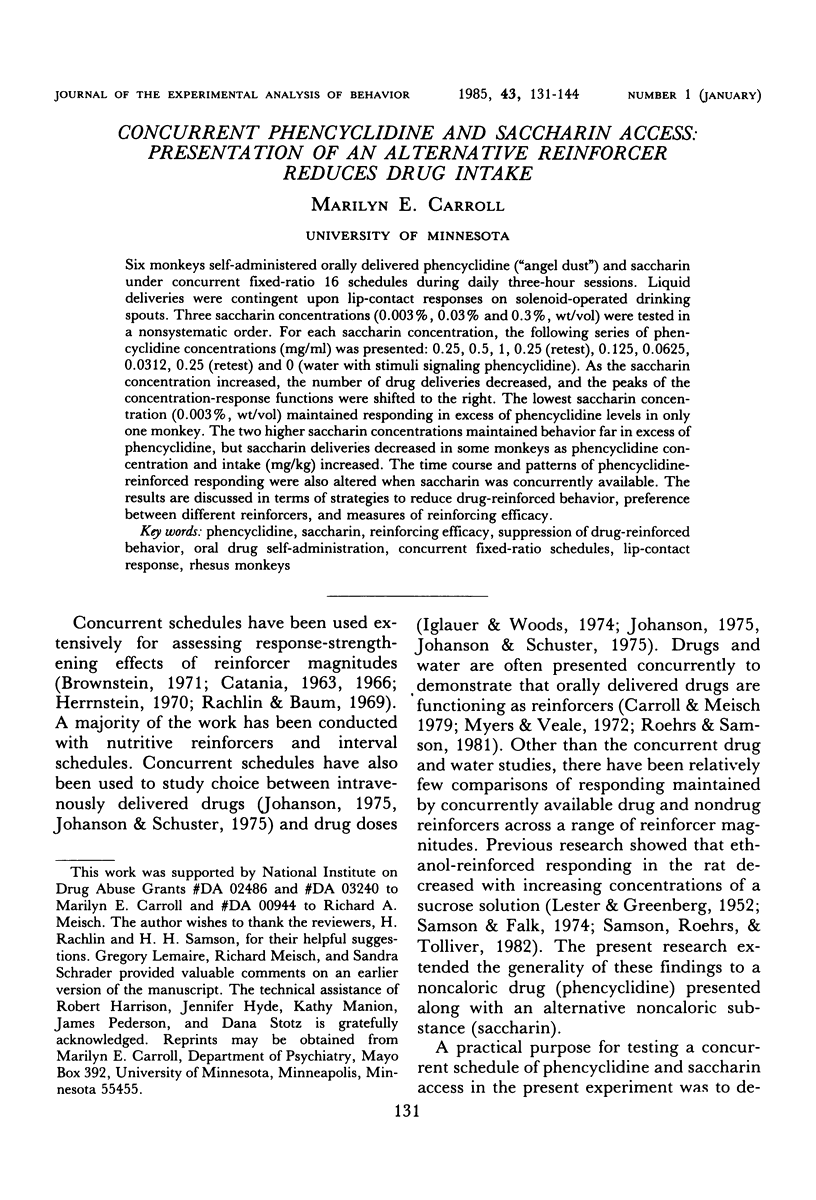



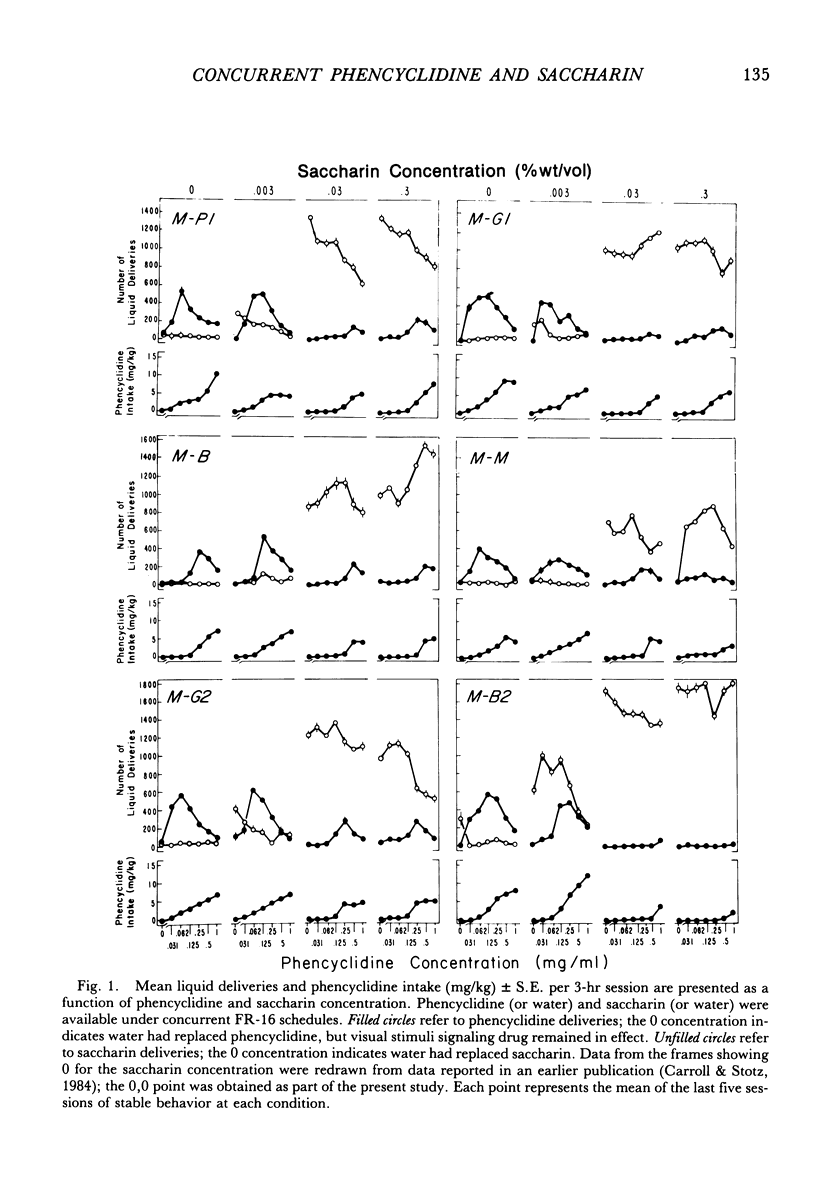
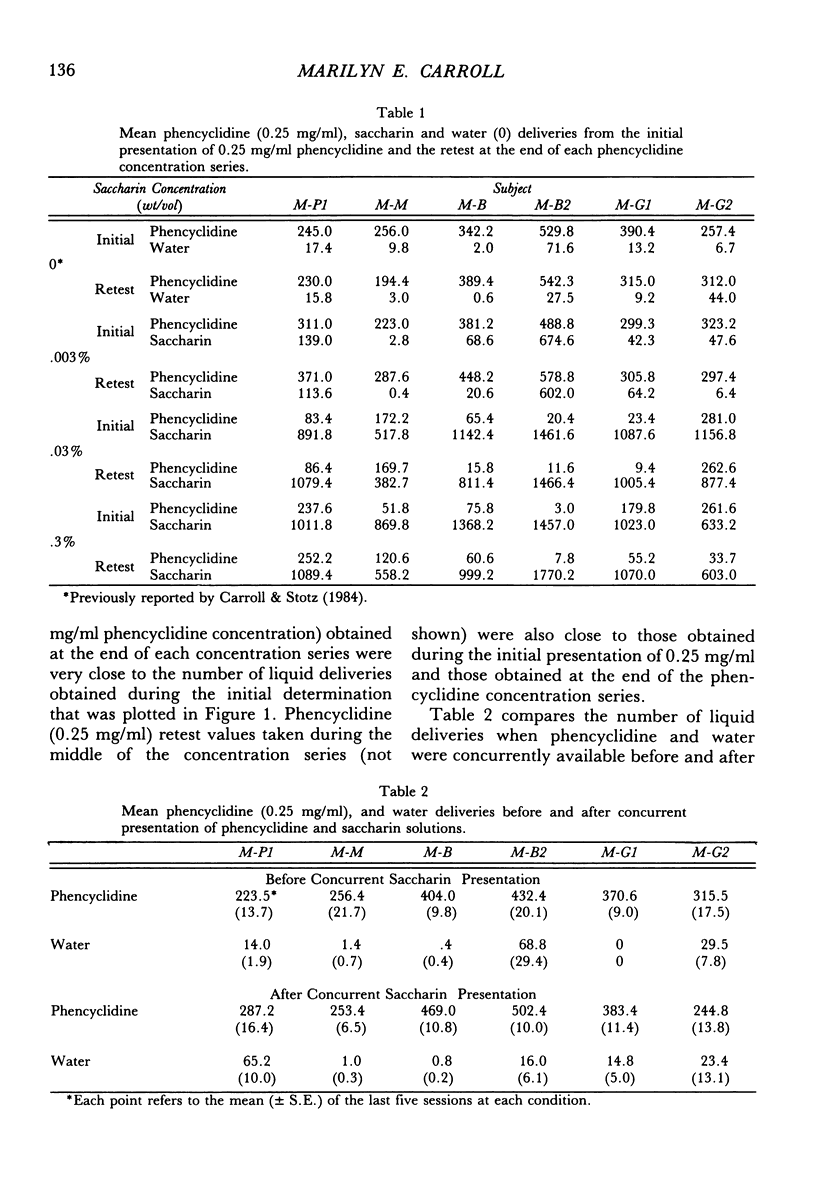
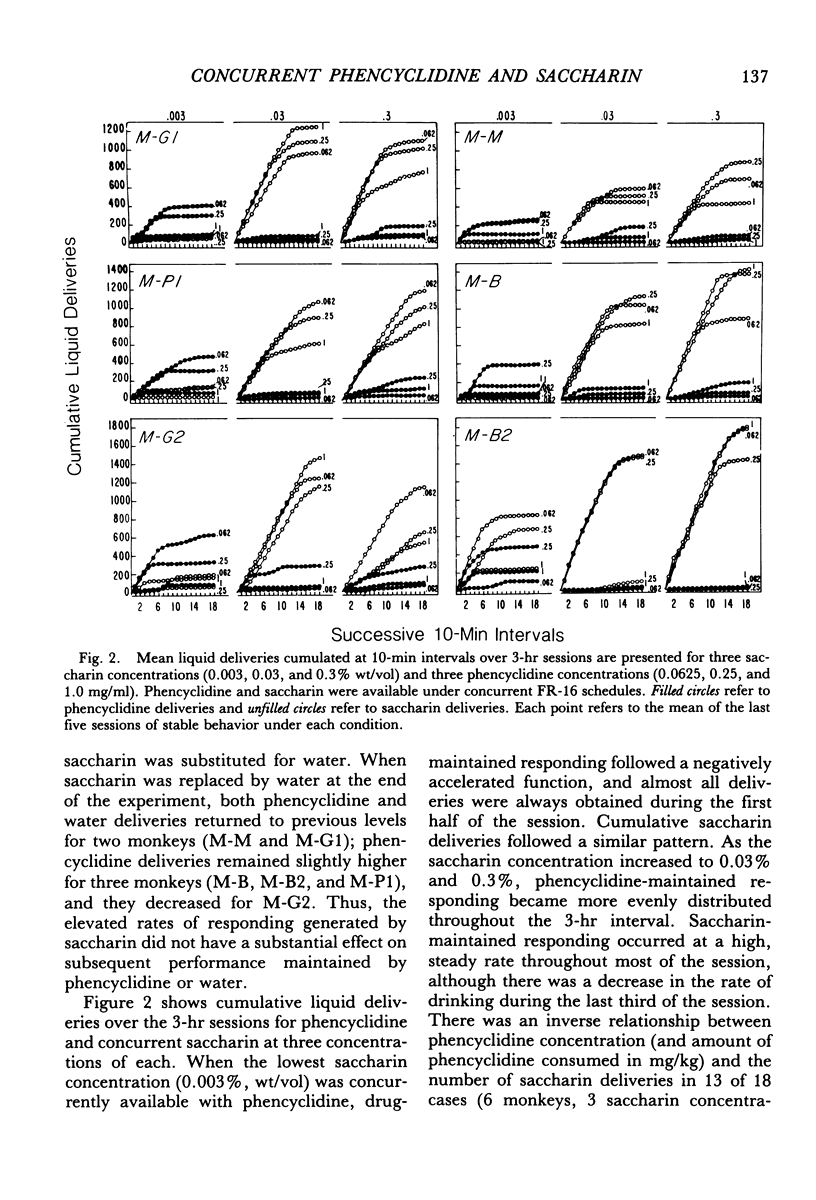





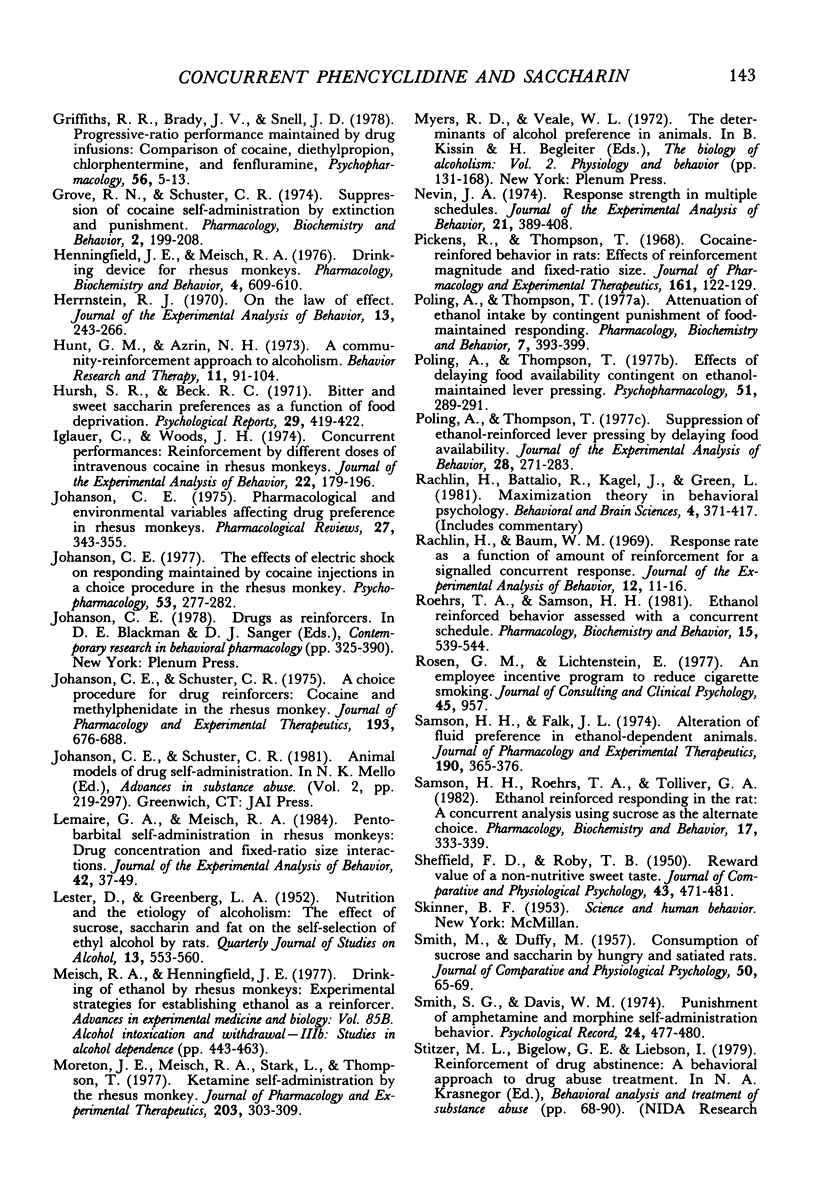

Selected References
These references are in PubMed. This may not be the complete list of references from this article.
- Aigner T. G., Balster R. L. Choice behavior in rhesus monkeys: cocaine versus food. Science. 1978 Aug 11;201(4355):534–535. doi: 10.1126/science.96531. [DOI] [PubMed] [Google Scholar]
- Bergman J., Johanson C. E. The effects of electric shock on responding maintained by cocaine in rhesus monkeys. Pharmacol Biochem Behav. 1981 Mar;14(3):423–426. doi: 10.1016/0091-3057(81)90413-5. [DOI] [PubMed] [Google Scholar]
- Bigelow G., Griffiths R., Liebson I. Experimental human drug self-administration: methodology and application to the study of sedative abuse. Pharmacol Rev. 1975 Dec;27(4):523–531. [PubMed] [Google Scholar]
- Brownstein A. J. Concurrent schedules of response-independent reinforcement: duration of a reinforcing stimulus. J Exp Anal Behav. 1971 Mar;15(2):211–214. doi: 10.1901/jeab.1971.15-211. [DOI] [PMC free article] [PubMed] [Google Scholar]
- CATANIA A. C. Concurrent performances: a baseline for the study of reinforcement magnitude. J Exp Anal Behav. 1963 Apr;6:299–300. doi: 10.1901/jeab.1963.6-299. [DOI] [PMC free article] [PubMed] [Google Scholar]
- Carroll M. E., Meisch R. A. Concurrent etonitazene and water intake in rats: role of taste, olfaction, and auditory stimuli. Psychopharmacology (Berl) 1979 Jun 28;64(1):1–7. doi: 10.1007/BF00427336. [DOI] [PubMed] [Google Scholar]
- Carroll M. E., Meisch R. A. Etonitazene as a reinforcer: oral intake of etonitazene by rhesus monkeys. Psychopharmacology (Berl) 1978 Dec 8;59(3):225–229. doi: 10.1007/BF00426626. [DOI] [PubMed] [Google Scholar]
- Carroll M. E., Meisch R. A. Oral phencyclidine (PCP) self-administration in rhesus monkeys: effects of feeding conditions. J Pharmacol Exp Ther. 1980 Aug;214(2):339–346. [PubMed] [Google Scholar]
- Carroll M. E. Oral self-administration of phencyclidine analogs by rhesus monkeys: conditioned taste and visual reinforcers. Psychopharmacology (Berl) 1982;78(2):116–120. doi: 10.1007/BF00432246. [DOI] [PubMed] [Google Scholar]
- Carroll M. E. Rapid acquisition of oral phencyclidine self-administration in food-deprived and food-satiated rhesus monkeys: concurrent phencyclidine and water choice. Pharmacol Biochem Behav. 1982 Aug;17(2):341–346. doi: 10.1016/0091-3057(82)90089-2. [DOI] [PubMed] [Google Scholar]
- Carroll M. E., Santi P. A., Rudell R. L. A microcomputer system for the control of behavioral experiments. Pharmacol Biochem Behav. 1981 Mar;14(3):415–417. doi: 10.1016/0091-3057(81)90411-1. [DOI] [PubMed] [Google Scholar]
- Carroll M. E., Stotz D. C. Increased phencyclidine self-administration due to food deprivation: interaction with concentration and training conditions. Psychopharmacology (Berl) 1984;84(3):299–303. doi: 10.1007/BF00555202. [DOI] [PubMed] [Google Scholar]
- Carroll M. E., Stotz D. C., Kliner D. J., Meisch R. A. Self-administration of orally-delivered methohexital in rhesus monkeys with phencyclidine or pentobarbital histories: effects of food deprivation and satiation. Pharmacol Biochem Behav. 1984 Jan;20(1):145–151. doi: 10.1016/0091-3057(84)90115-1. [DOI] [PubMed] [Google Scholar]
- Carroll M. E. Tolerance to the behavioral effects of orally self-administered phencyclidine. Drug Alcohol Depend. 1982 Jul;9(3):213–224. doi: 10.1016/0376-8716(82)90046-1. [DOI] [PubMed] [Google Scholar]
- Falk J. L. Drug dependence: myth or motive? Pharmacol Biochem Behav. 1983 Sep;19(3):385–391. doi: 10.1016/0091-3057(83)90106-5. [DOI] [PubMed] [Google Scholar]
- Griffiths R. R., Brady J. V., Snell J. D. Progressive-ratio performance maintained by drug infusions: comparison of cocaine, diethylpropion, chlorphentermine, and fenfluramine. Psychopharmacology (Berl) 1978 Jan 31;56(1):5–13. doi: 10.1007/BF00571401. [DOI] [PubMed] [Google Scholar]
- Griffiths R., Bigelow G., Liebson I. Suppression of ethanol self-administration in alcoholics by contingent time-out from social interactions. Behav Res Ther. 1974 Nov;12(4):327–334. doi: 10.1016/0005-7967(74)90007-2. [DOI] [PubMed] [Google Scholar]
- Grove R. N., Schuster C. R. Suppression of cocaine self-administration by extinction and punishment. Pharmacol Biochem Behav. 1974 Mar-Apr;2(2):199–208. doi: 10.1016/0091-3057(74)90053-7. [DOI] [PubMed] [Google Scholar]
- Henningfield J. E., Meisch R. A. Drinking device for rhesus monkeys. Pharmacol Biochem Behav. 1976 May;4(5):609–610. doi: 10.1016/0091-3057(76)90204-5. [DOI] [PubMed] [Google Scholar]
- Herrnstein R. J. On the law of effect. J Exp Anal Behav. 1970 Mar;13(2):243–266. doi: 10.1901/jeab.1970.13-243. [DOI] [PMC free article] [PubMed] [Google Scholar]
- Hunt G. M., Azrin N. H. A community-reinforcement approach to alcoholism. Behav Res Ther. 1973 Feb;11(1):91–104. doi: 10.1016/0005-7967(73)90072-7. [DOI] [PubMed] [Google Scholar]
- Hursh S. R., Beck R. C. Bitter and sweet saccharin preferences as a function of food deprivation. Psychol Rep. 1971 Oct;29(2):419–422. doi: 10.2466/pr0.1971.29.2.419. [DOI] [PubMed] [Google Scholar]
- Iglauer C., Woods J. H. Concurrent performances: reinforcement by different doses of intravenous cocaine in rhesus monkeys. J Exp Anal Behav. 1974 Jul;22(1):179–196. doi: 10.1901/jeab.1974.22-179. [DOI] [PMC free article] [PubMed] [Google Scholar]
- Johanson C. E. Pharmacological and environmental variables affecting drug preference in rhesus monkeys. Pharmacol Rev. 1975 Sep;27(3):343–355. [PubMed] [Google Scholar]
- Johanson C. E., Schuster C. R. A choice procedure for drug reinforcers: cocaine and methylphenidate in the rhesus monkey. J Pharmacol Exp Ther. 1975 May;193(2):676–688. [PubMed] [Google Scholar]
- Johanson C. E. The effects of electric shock on responding maintained by cocaine injections in a choice procedure in the rhesus monkey. Psychopharmacology (Berl) 1977 Aug 16;53(3):277–282. doi: 10.1007/BF00492364. [DOI] [PubMed] [Google Scholar]
- LESTER D., GREENBERG L. A. Nutrition and the etiology of alcoholism; the effect of sucrose, saccharin and fat on the self-selection of ethyl alcohol by rats. Q J Stud Alcohol. 1952 Dec;13(4):553–560. [PubMed] [Google Scholar]
- Lemaire G. A., Meisch R. A. Pentobarbital self-administration in rhesus monkeys: drug concentration and fixed-ratio size interactions. J Exp Anal Behav. 1984 Jul;42(1):37–49. doi: 10.1901/jeab.1984.42-37. [DOI] [PMC free article] [PubMed] [Google Scholar]
- Meisch R. A., Henningfield J. E. Drinking of ethanol by rhesus monkeys: experimental strategies for establishing ethanol as a reinforcer. Adv Exp Med Biol. 1977;85B:443–463. doi: 10.1007/978-1-4615-9038-5_29. [DOI] [PubMed] [Google Scholar]
- Moreton J. E., Meisch R. A., Stark L., Thompson T. Ketamine self-administration by the rhesus monkey. J Pharmacol Exp Ther. 1977 Nov;203(2):303–309. [PubMed] [Google Scholar]
- Nevin J. A. Response strength in multiple schedules. J Exp Anal Behav. 1974 May;21(3):389–408. doi: 10.1901/jeab.1974.21-389. [DOI] [PMC free article] [PubMed] [Google Scholar]
- Pickens R., Thompson T. Cocaine-reinforced behavior in rats: effects of reinforcement magnitude and fixed-ratio size. J Pharmacol Exp Ther. 1968 May;161(1):122–129. [PubMed] [Google Scholar]
- Poling A., Thompson T. Attenuation of ethanol intake by contingent punishment of food-maintained responding. Pharmacol Biochem Behav. 1977 Oct;7(4):393–399. doi: 10.1016/0091-3057(77)90236-2. [DOI] [PubMed] [Google Scholar]
- Poling A., Thompson T. Effects of delaying food availability contingent on ethanol-maintained lever pressing. Psychopharmacology (Berl) 1977 Mar 16;51(3):289–291. doi: 10.1007/BF00431638. [DOI] [PubMed] [Google Scholar]
- Poling A., Thompson T. Suppression of ethanol-reinforced lever pressing by delaying food availability. J Exp Anal Behav. 1977 Nov;28(3):271–283. doi: 10.1901/jeab.1977.28-271. [DOI] [PMC free article] [PubMed] [Google Scholar]
- Rachlin H., Baum W. M. Response rate as a function of amount of reinforcement for a signalled concurrent response. J Exp Anal Behav. 1969 Jan;12(1):11–16. doi: 10.1901/jeab.1969.12-11. [DOI] [PMC free article] [PubMed] [Google Scholar]
- Roehrs T. A., Samson H. H. Ethanol reinforced behavior assessed with a concurrent schedule. Pharmacol Biochem Behav. 1981 Oct;15(4):539–544. doi: 10.1016/0091-3057(81)90204-5. [DOI] [PubMed] [Google Scholar]
- Rosen G. M., Lichtenstein E. An employee incentive program to reduce cigarette smoking. J Consult Clin Psychol. 1977 Oct;45(5):957–957. [PubMed] [Google Scholar]
- SHEFFIELD F. D., ROBY T. B. Reward value of a non-nutritive sweet-taste. J Comp Physiol Psychol. 1950 Dec;43(6):471–481. doi: 10.1037/h0061365. [DOI] [PubMed] [Google Scholar]
- SMITH M., DUFFY M. Consumption of sucrose and saccharine by hungry and satiated rats. J Comp Physiol Psychol. 1957 Feb;50(1):65–69. doi: 10.1037/h0041824. [DOI] [PubMed] [Google Scholar]
- Samson H. H., Falk J. L. Alteration of fluid preference in ethanol-dependent animals. J Pharmacol Exp Ther. 1974 Aug;190(2):365–376. [PubMed] [Google Scholar]
- Samson H. H., Roehrs T. A., Tolliver G. A. Ethanol reinforced responding in the rat: a concurrent analysis using sucrose as the alternate choice. Pharmacol Biochem Behav. 1982 Aug;17(2):333–339. doi: 10.1016/0091-3057(82)90088-0. [DOI] [PubMed] [Google Scholar]
- Wilson G. T., Leaf R. C., Nathan P. E. The aversive control of excessive alcohol consumption by chronic alcoholics in the laboratory setting. J Appl Behav Anal. 1975 Spring;8(1):13–26. doi: 10.1901/jaba.1975.8-13. [DOI] [PMC free article] [PubMed] [Google Scholar]
- Woolverton W. L., Balster R. L. Effects of antipsychotic compounds in rhesus monkeys given a choice between cocaine and food. Drug Alcohol Depend. 1981 Aug;8(1):69–78. doi: 10.1016/0376-8716(81)90088-0. [DOI] [PubMed] [Google Scholar]
- Wurster R. M., Griffiths R. R., Findley J. D., Brady J. V. Reduction of heroin self-administration in baboons by manipulation of behavioral and pharmacological conditions. Pharmacol Biochem Behav. 1977 Dec;7(6):519–528. doi: 10.1016/0091-3057(77)90248-9. [DOI] [PubMed] [Google Scholar]


